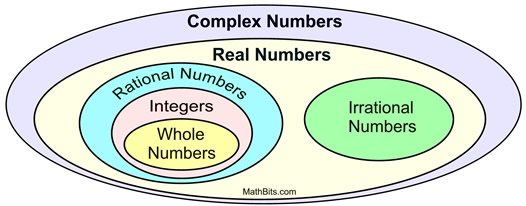can you find the square root of a negative number
Let'southward investigate what happens when negative values appear under the radical symbol (equally the radicand) for cube roots and square roots.
In some situations, negative numbers under a radical symbol are OK. For example, ![]() is not a problem since (-2) • (-2) • (-2) = -8, making the respond -ii. In cube root problems, it is possible to multiply a negative value times itself three times and get a negative reply.
is not a problem since (-2) • (-2) • (-2) = -8, making the respond -ii. In cube root problems, it is possible to multiply a negative value times itself three times and get a negative reply.
Difficulties, however, develop when we look at a problem such as ![]() . This foursquare root problem is request for a number multiplied times itself that will requite a product (answer) of -16. There simply is no way to multiply a number times itself and become a negative result. Consider: (4) • (four) = sixteen and (-4) • (-four) = 16.
. This foursquare root problem is request for a number multiplied times itself that will requite a product (answer) of -16. There simply is no way to multiply a number times itself and become a negative result. Consider: (4) • (four) = sixteen and (-4) • (-four) = 16.
| CUBE ROOTS: | BUT | SQUARE ROOTS: |
| Yep, (-ii) ten (-2) ten (-2) = -eight. | Nope! (4) x (4) ≠ -16. |
![]() Square roots are the culprits! The difficulties arise when you see a negative value nether a square root. It is non possible to square a value (multiply it times itself) and arrive at a negative value. And so, what exercise we exercise?
Square roots are the culprits! The difficulties arise when you see a negative value nether a square root. It is non possible to square a value (multiply it times itself) and arrive at a negative value. And so, what exercise we exercise?
| | The square root of a negative number does not exist among the set up of Real Numbers. |
When problems with negatives under a foursquare root first appeared, mathematicians thought that a solution did not exist. They saw equations such every bit x 2 + 1 = 0 , and wondered what the solution In an effort to address this problem, mathematicians "created" a new number,![]() really meant.
really meant.
| | The imaginary number "i" is the foursquare root of negative one. |
![]()
An imaginary number possesses the unique property that when squared, the issue is negative.

Consider: ![]()
The process of simplifying a radical containing a negative gene is the same as normal radical simplification. The only deviation is that the ![]() will be replaced with an " i ".
will be replaced with an " i ".
Equally research with imaginary numbers continued, it was discovered that they really filled a gap in mathematics and served a useful purpose. Imaginary numbers are essential to the study of sciences such as electricity, quantum mechanics, vibration analysis, and cartography.
When the imaginary i was combined with the set of Real Numbers, the all encompassing set of Complex Numbers was formed.

Production Rule
![]()
where a ≥ 0, b≥ 0
"The foursquare root of a product is equal to the product of the square roots of each factor."
This theorem allows us to use our method of simplifying radicals.
Imaginary (Unit) Number ![]()
![]()
Production Dominion
(extended) ![]() where a ≥ 0, b≥ 0
where a ≥ 0, b≥ 0
OR a ≥ 0, b < 0
but
Not a < 0, b < 0 ![]()
FYI: The powers of i e'er cycle through just four dissimilar values:
i 1 = i
i 2 = -1
i 3 = -i
i 4 = i
i 5 = i and the cycle starts again.
When doing arithmetics on i , care for it equally yous would an "ten".
3 i + 4 i = 7 i
2 i • 4 i = 8 i 2 = -8
Note: i 2 was replaced with -1.
Do NOT confuse "irrational" numbers
with
"imaginary" numbers.
They are Not the same.
Complex Numbers
a ± bi
where a and b are real numbers, and i is the imaginary unit of measurement.
Complex numbers are written in the standard grade a + bi.
In Algebra 1, you will see that the "imaginary" number will exist useful when solving quadratic equations. The quadratic formula may requite complex solutions, written as a ± bi, where a and b are real numbers.
You will see more than about imaginary numbers in the Quadratic section.
Source: https://mathbitsnotebook.com/Algebra1/Radicals/RADNegativeUnder.html
Posted by: hiebertclould.blogspot.com

0 Response to "can you find the square root of a negative number"
Post a Comment